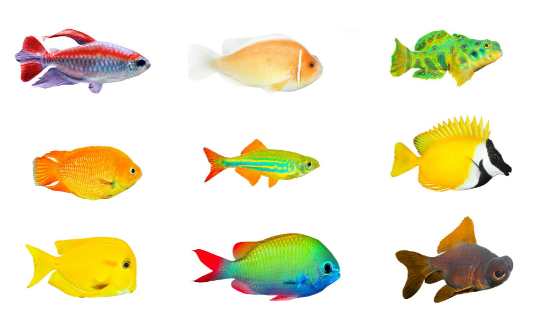
Are you searching for a freshwater fish that will bring a burst of color and serenity to your aquarium? Look no further than the mesmerizing Peacock Cichlids. These beautiful creatures, with their vibrant hues and peaceful demeanor, are like living pieces of art gracefully swimming through the water.
But there's more to these stunning fish than meets the eye. Stay tuned to learn about their fascinating behavior, compatibility with other species, unique feeding habits, and the secrets to successfully breeding these captivating Peacock Cichlids.
Get ready to embark on a journey into a world of vibrant beauty and tranquil companionship.
Key Takeaways
- Peacock Cichlids are medium-sized freshwater fish known for their vibrant colors.
- They are relatively peaceful compared to other Lake Malawi cichlids and can be kept with other cichlids and peaceful community species.
- Peacock Cichlids require a medium to large-sized aquarium with a sandy substrate and rocks for caves and hiding places.
- They are insectivores and should be fed sinking pellets, wafers, or granules, as well as fresh and frozen foods.
General Information
Peacock Cichlids are medium-sized freshwater fish known for their vibrant colors and peaceful nature. These stunning fish are relatively peaceful compared to other Lake Malawi cichlids, making them great additions to your home aquarium. They can be kept with other cichlids and peaceful community species. While the males can be territorial, they aren't aggressive towards other fish.
Endemic to Lake Malawi in eastern Africa, Peacock Cichlids can be found in many places across the globe. There are 22 identified species of Peacock Cichlids, with popular varieties including African Butterfly Peacock, Aulonocara Blue Gold Cichlid, and Sunshine Peacock.
With their beautiful colors and peaceful temperament, Peacock Cichlids are a must-have for any aquarium enthusiast.
Habitat and Distribution
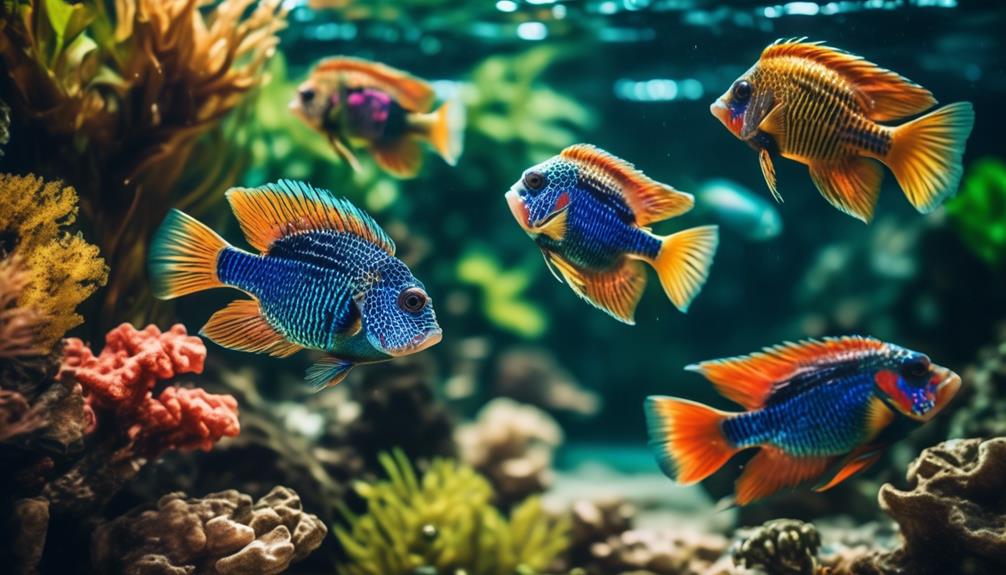
Endemic to Lake Malawi in eastern Africa, Peacock Cichlids can be found in various habitats across the globe. These stunning fish thrive in the rocky areas of Lake Malawi, where they can hide among the crevices and caves. They prefer warm, alkaline water with a pH level ranging from 7.8 to 8.6.
In the wild, Peacock Cichlids are known to inhabit the sandy bottoms of the lake, sifting through the substrate in search of food. They're also found in the open water, swimming gracefully and displaying their vibrant colors.
Due to their popularity in the aquarium trade, Peacock Cichlids can now be found in home aquariums all around the world, bringing beauty and tranquility to their owners.
Popular Varieties
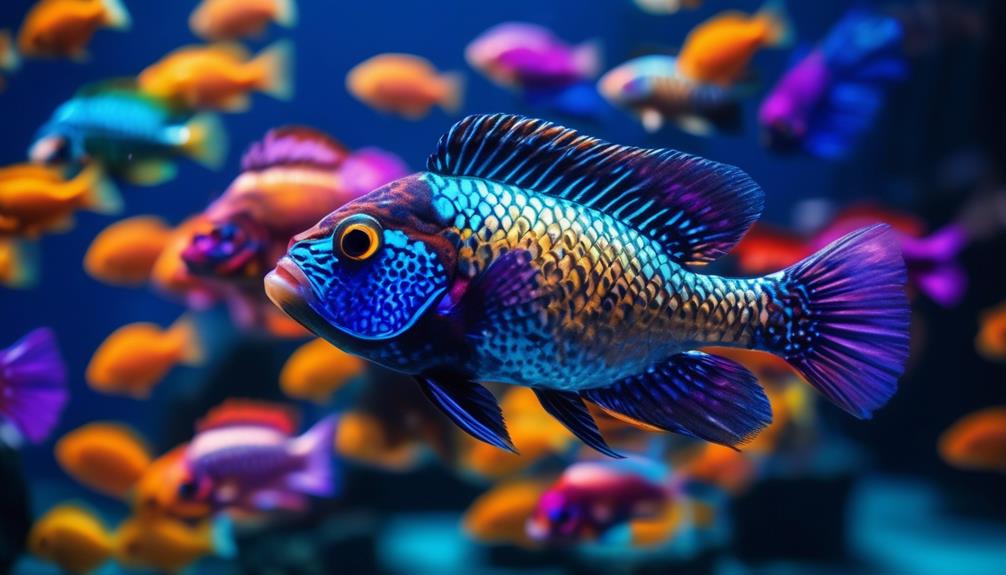
As we shift our focus to the captivating world of Peacock Cichlids, let's explore the diverse array of popular varieties that enthusiasts can choose from. These stunning fish come in a wide range of colors and patterns, each with its own unique beauty.
Here are two popular sub-varieties:
- African Butterfly Peacock:
- This variety is known for its vibrant colors and striking patterns resembling the wings of a butterfly.
- With hues of red, orange, blue, and yellow, it creates a mesmerizing display in any aquarium.
- Aulonocara Blue Gold Cichlid:
- This variety showcases a stunning combination of blue and gold hues, creating a regal appearance.
- Its shimmering scales and graceful movements make it a favorite among aquarists.
These are just a few examples of the stunning varieties available. Whether you prefer bold and vibrant colors or subtle and elegant patterns, there's a Peacock Cichlid variety to suit every taste.
Aquarium Requirements
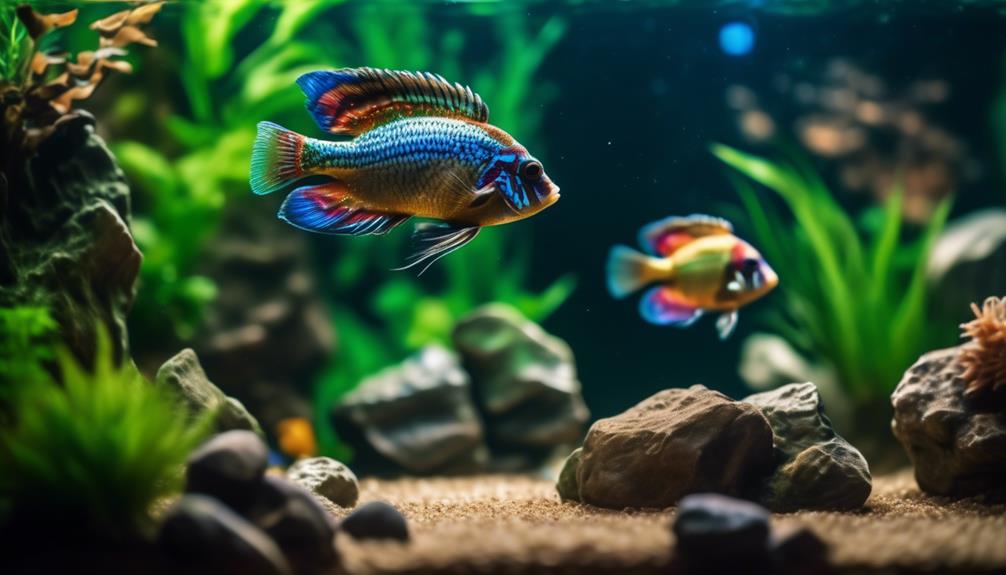
To create a suitable habitat for Peacock Cichlids, you will need to ensure that their aquarium meets specific requirements. These vibrant and peaceful freshwater fish require a medium to large-sized aquarium with a sandy substrate and rocks for caves and hiding places. They prefer a water pH range of 7.8 to 8.6 and a water hardness of 4 to 6 dH. The temperature should be maintained between 76F to 85F at the surface. It's important to note that Peacock Cichlids do not eat plants, so you can focus on providing them with sinking pellets, wafers, or granules. Additionally, offering fresh and frozen foods will enhance their diet. Take a look at the table below for a summary of the aquarium requirements for Peacock Cichlids:
| Requirement | Range |
|---|---|
| Aquarium Size | Medium to Large |
| Water pH | 7.8 to 8.6 |
| Water Hardness | 4 to 6 dH |
| Temperature | 76F to 85F |
Behavior and Compatibility
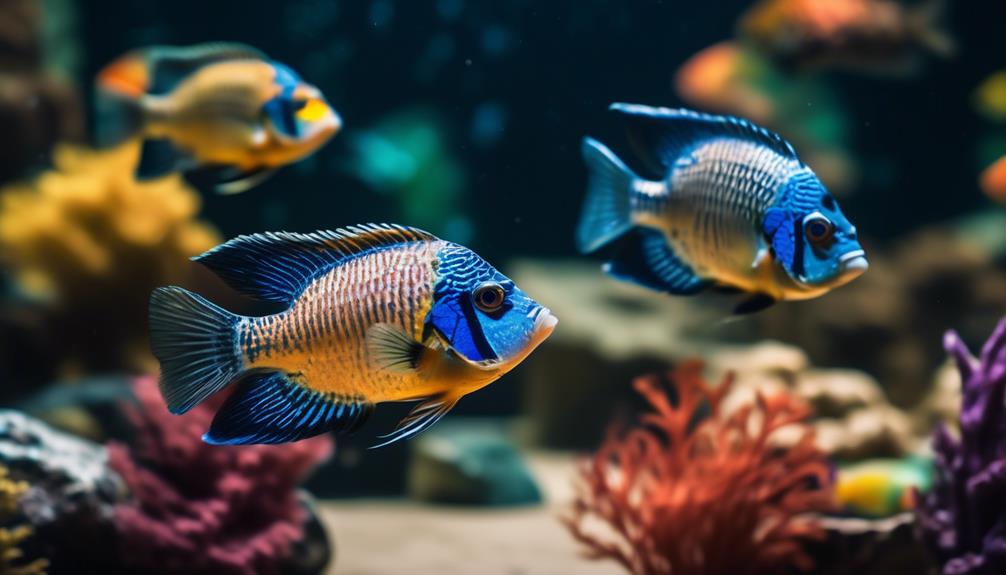
Now let's explore the behavior and compatibility of Peacock Cichlids, building off the foundation we've established regarding their aquarium requirements.
- Behavior:
- Peacock Cichlids are relatively peaceful but can be territorial.
- Males are solitary and territorial.
- They aren't aggressive towards other fish species.
- Research is needed to determine suitable tank mates.
- Compatibility:
- Peacock Cichlids can be kept with other Peacock Cichlids without much conflict.
- They can also coexist with small to medium-sized community fish.
- It's important to monitor their behavior and make adjustments if any aggression occurs.
- Providing enough hiding places and territories can help minimize conflicts in the tank.
Understanding the behavior and compatibility of Peacock Cichlids is crucial for creating a harmonious and vibrant aquarium environment. By ensuring suitable tank mates and monitoring their behavior, you can enjoy the stunning beauty of these fish without any unnecessary conflicts.
Feeding and Breeding
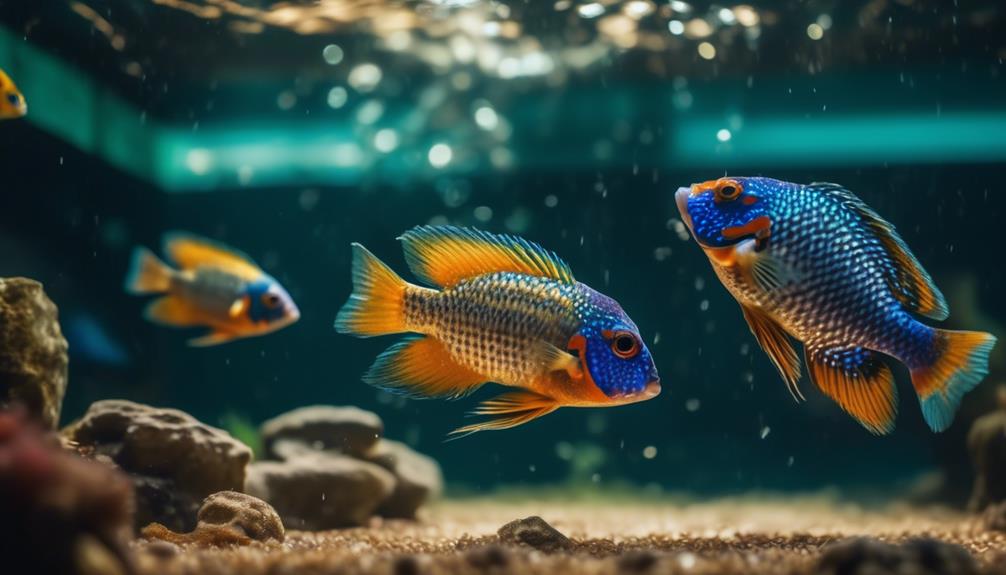
How do Peacock Cichlids feed and reproduce?
Peacock Cichlids are insectivores and they feed on sinking pellets, wafers, and granules. It's also important to offer them fresh and frozen foods. They're benthic species, which means they sift through the substrate for their food. Unlike other fish, they don't come up to the surface to eat.
When it comes to reproduction, male and female Peacock Cichlids are easy to distinguish. Males are territorial and solitary, while females are mouth brooders. They incubate fertilized eggs in their mouths and care for the fry for a short time. However, they aren't dedicated parents.
Frequently Asked Questions
How Long Do Peacock Cichlids Live?
Peacock Cichlids can live for around 8 to 10 years in the right conditions. With proper care, a healthy diet, and a suitable environment, you can enjoy their vibrant beauty for many years.
Can Peacock Cichlids Be Kept in a Community Tank With Aggressive Fish?
Yes, you can keep Peacock Cichlids in a community tank with aggressive fish, as long as they are small to medium-sized. However, research is needed to ensure suitable tank mates for compatibility.
What Is the Average Size of a Fully-Grown Peacock Cichlid?
A fully-grown Peacock Cichlid can reach an average size of 4 to 6 inches. They are medium-sized freshwater fish known for their vibrant colors and relatively peaceful nature.
Do Peacock Cichlids Require Any Special Lighting in Their Aquarium?
No, peacock cichlids do not require any special lighting in their aquarium. They can thrive in regular aquarium lighting as long as it provides a natural day-night cycle.
How Often Should Peacock Cichlids Be Fed in a Day?
Peacock Cichlids should be fed once or twice a day. Offer sinking pellets, wafers, or granules, along with fresh and frozen foods. Remember, they are benthic species, so they sift through the substrate for food.
Are Peacock Cichlids and Guppies Compatible in the Same Tank?
Peacock Cichlids and guppies can coexist in the same tank, as long as the tank is spacious and well-decorated. Peacock Cichlids are territorial and may become aggressive, but the vibrant world of guppies can provide them with enough distractions. It’s important to monitor their interactions closely to ensure a peaceful environment.
Conclusion
In conclusion, Peacock Cichlids are a fantastic addition to any freshwater aquarium. With their vibrant colors and peaceful nature, they bring both beauty and tranquility to your tank.
These fish are relatively easy to care for and can be kept with other cichlids and peaceful community species. By providing them with a suitable habitat and feeding them a varied diet, you can ensure their well-being and enjoy their stunning presence in your aquarium.




